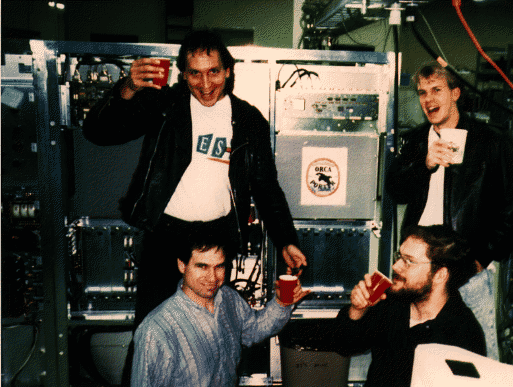
Jean-Yves Leclerc was unable to find funding for a supercomputer project in Europe, so he came to the US to raise funding and interest. Dave Evans of Evans & Sutherland had been Leclerc's mentor during his graduate studies in the US, and Leclerc succeeded in persuading Evans & Sutherland to create a new division to build high-performance computers. The business logic was that many E&S customers were using Cray machines in conjunction with E&S graphic, and that a machine specifically tailored to the needs of visual simulation and seamlessly integrated with E&S graphics capabilities would find a ready market.
The machine was code-named "Orca", and was to be sold as the ES-1.
The project kicked off in 1996, and folded in January 1990.
The ES-1 had a two-level crossbar interconnect. At the first level, up to 16 processors were connected to up to eight memory cards. Second-level interconnect would have allowed up to 128 processors in a system, all sharing memory, albeit with some pretty daunting memory delays.
Each processor was in fact called a "functional unit" or "compute unit", and a card-cage populated with 16 of these CUs was referred to as a "processor" in ESCD terminology. This allowed favorable per-"processor" performance comparisons with other supercomputers!
The integer/control portion of the CPU had an instruction set that emphasized latency tolerance. Up to 8 integer load/store memory operations could be in flight at the same time, with precise exceptions guaranteed in the event of a fault. Branches had a variable delay slot, the end of which was signaled by a "split" bit in a subsequent instruction, which indicated that the tagged instruction marked a split in the instruction stream, and is the last to issue before the preceding branch condition is resolved.
The FPU was in fact an off-the-shelf design from Weitek.
The memory architecture was a bit unusual and complex. For example, the memory modules also contained much of the interrupt arbitration logic. The reasoning was that, since I/O channels and CPUs entered along the same axis of the crossbar, interrupt packets had to pass through memory to get to a CPU. Therefore, the CPUs were obliged to communicate their interrupt mask levels to the memory controllers, to allow interrupts to be sent to ready CPUs.
The non-commodity components were CMOS designs synthesised using the Silicon Compilers tools. Memory was MOS DRAM.
The OS was based on early versions of MACH from CMU. It was certainly the first multiprocessor version of Mach delivered to a customer (in Beta form, at least). The compilers used Compass front ends, but the back end was developed internally.
The physical packaging scheme was clean and economical. The ES-1 would have been the most powerful air-cooled machine of its day.
The compilers were very good at filling more load delay slots than the literature suggested should have been possible.
The architectural principles were too heavily compromised by the implementation technology and techniques. What started as a multithreaded machine ended up as merely a set of CPUs that supported a largish number (for the day) of outstanding memory requests.
The silicon compilation technology employed resulted in large, slow chips, limiting the chip yield to dangerously low levels and yielding a maximum clock speed of 40Mhz for the FPUs, and half that for the custom integer pipelines. This was not terribly impressive for a "supercomputer", even in 1989.
Because of a naive belief that the design was correct "because we simulated it", little or no provision was made to observe the internal state of the machine during bring-up.
The crossbar arbitration algorithm was patented. And defective. Rather than implement FIFO or round-robin, it used a scheme which alternated priority between the "rightmost" requestor and the "leftmost" requestor. Under load, requestors in the middle would get no service for unbounded periods of time. Memory delays of thousands of cycles were often seen. The project was in deep trouble by late 1999, but the need to redesign and respin the crossbar was the last straw. The project was shut down instead.
Don't believe what the design automation salesman tells you his tools will let you do.
There are never enough cycles to fully simulate a complex design before tape-out. Assume that there will be bugs, and that they will have to be hunted down.
The chilled air system of the ES-1 had been used for months on the factory floor by the ESCD manufacturing workers to cool down their soft drinks on hot days. As the "drop dead" date for financial rescue drew closer with no help in sight, the ESCD OS team conspired with the mechanical engineering team to develop a variant of the machine, called the ES-1B. The "B" stood for beer. The internal bulkheads of one of the card cages were relocated to provide vertical clearance for a quarter-keg of beer. The been chosen was, logically enough, Orca Porter, from a microbrewerey in Oakland. This rare photo shows the OS team taking the ES-1B through its paces on the day we all got laid off.

Photo (c) Kevin D. Kissell
George Spix, then of SSI, commented after the demise of ESCD: "They found a really easy way to solve 80% of the problem."
This account was posted without attribution to comp.sys.super by Eugene Miya as part of a FAQ. If anyone knows who wrote it, I would love to give a correct attribution. I'm sure I know the guy!